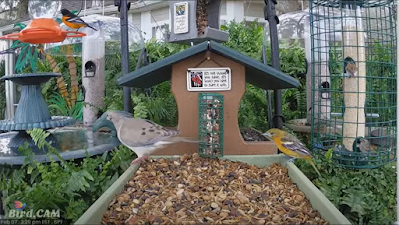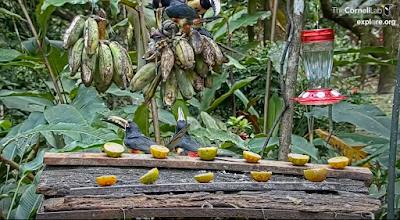A bit of a different post today. Friday evening I had a thought, "I wonder how many bird species I could see in a day using feeder cams?" I quickly checked the weather, and saw that is was supposed to snowy all weekend, so I figured I may as well give it a shot. As it turned out, both days were gorgeous and probably the nicest days we have had in awhile, but whatever, I was committed.
I found a website (click here) that had had links to dozens of feeder cams from all over the world, although the majority of the cams were from the Americas and Europe, and used that to view different remote camera. Cornell also hosts a few feeder cams, which I utilized as well. Because time zones are a thing, there was always at least one camera with day light! I will include links for the some of the better cams I used. I have very little experience with birds outside of North America, so I was looking forward to learning about some ones I may not be familiar with!
So, at 12am EST, I began my day in South Africa. I have never really given much thought to African birds (although it is a place I have always wanted to go), so everything was more or less new to me. Cape Sparrows and Southern Masked-weavers dominated the feeders, but also present were House Sparrows, a Speckled Mousebird, and a Red-eyed Dove.
Quickly a flipped over to Japan, which is where I was greeted by Brambling, Willow Tit, Japanese Tit, and Oriental Greenfinches.
With a click, I found myself in Australia, where I got Crested Pigeon. Overall, I was pretty disappointed with the cams in Australia, but I still managed to get a few unique species over the course of the day.
In South Korea, I saw some Varied Tits and Eurasian Tree Sparrows.
After my initial frenzy of picking up species, I spent the next couple hours switching between cams. In South Africa, I got Dark-capped Bulbul, Southern Boubou, Cape Starling, Black-collared Barbet, Red-winged Starling, Arrow-marked Babbler, African Grey Hornbill and Karoo Thrush, to name a few. In Japan I found a Eurasian Nuthatch. Australia was kind to me and and gave me Galah and a Rock Pigeon. I made a brief stop into Israel and got a Palestine Sunbird.
Eventually, the sun started to come up in Europe, and I got a Eurasian Blackbird and Eurasian Siskins in Slovakia. In Poland, some European Goldfinches, European Greenfinch, Blue Tits, Great Tits, and a Great Spotted Woodpecker were coming to a feeder. On another cam in Poland, there were some Coal Tits, Crested Tits and European Robins. Ring-necked Pheasant, Wood Pigeon, and Eurasian Wren were found in England. In the Czech Republic, I was treated with Eurasian Jays, Hawfinch, and Eurasian Collared-Dove. I gave Scotland a try, and saw Long-tailed Tits, Common Chaffinches, and a Common Buzzard, a big surprise.
After a few more birds coming from Africa (Cape White-eye, Hadeda Ibis, Green Wood Hoopoe etc.) and a Sulphur-crested Cockatoo from Australia, I decided to go to sleep for a couple hours (it was 4am by this point). I figured I wouldn't add too many more birds until things started waking up in the Americas.
A couple hours later I broke up, and the first birds I looked at in Scotland were Eurasian Bullfinches, my only ones all day. I tuned into the Panama cam, and saw a Rufous Motmot in the dark. I found a cam in Brazil that was pretty low quality, but I had Saffron Finches, Ruddy Ground-doves, Picazuro Pigeon, and even a Boat-billed Flycatcher. One of my favourite cams of the day, despite not being the most active, was in Ecuador, where I saw Golden-naped Tanager and Thick-billed Euphonia (?). Back in Panama, Gray-headed Chachalaca, Clay-colored Thrush, Blue-grey Tanager, and Dusky-faced Tanager made an appearance, all of which were fairly reliable all day.
 |
| Clay-colored Thrushes and Blue-grey Tanagers in Panama |
Finally, the sun started to rise in northeastern North America. The first cam I tuned into was New York, which resulted in a bunch of the typical winter feeder birds we are familiar with here. A cam in Alabama was pretty fun, which has Yellow-rumped Warblers, Eastern Bluebird, and Eastern Phoebe.
Back in Ecuador, some hummingbirds were starting to show up, including White-whiskered Hermit and Rufous-tailed Hummingbird. A Grey-cowled Wood Rail came to check out the feeder in Panama.
 |
| Rufous-tailed Hummingbird |
I spent the next few hours flipping back and forth between cams in South/Central America and North America. In Ontario I added Hairy Woodpecker, Pine Grosbeak, and Common Redpoll. Ohio brought my only American Goldfinches of the day. I checked out Texas, which was very kind to me throughout the day, giving me things like Bushtit, Carolina Chickadee, Black-crested Titmouse, Acorn Woodpecker, and Woodhouse's Scrub-jay. I made a quick stop in California, where I picked up Allen's and Anna's Hummingbird, as well as an Orange-crowned Warbler. In Alberta, I saw a Northern Flicker.
Ecuador came through with a few more things, including Summer Tanager, Swainson's Thrush, Andean Emerald, Booted Racket-tail, and Silver-throated Tanager.
 |
| Rufous-tailed Hummingbird and Summer Tanager in Ecuador |
After waiting for hours, I finally got on the Western Meadowlark that has been coming to the feeder in Ontario since November. A virtual "twitch".
By mid-day I had managed to rack up a whopping 130 species.
The afternoon was pretty quiet, but here and there I managed to spot a new bird.
In Panama, Crimson-backed Tanagers and Black-chested Jays began to show up. I looked over at my screen for a brief second and managed to catch a Chestnut-headed Oropendola for a couple seconds.
I had a couple new additions in Texas, in the form of a Bewick's Wren and Wild Turkeys, which I saw running around in the background.
I found a cam in Florida, which gave me my first Chipping Sparrows of the day, as well as my only Baltimore Orioles.
I heard some rustling coming from Ontario, and when I switched to that tab I was surprised to find a Canada Jay. A bit later I also got a Common Raven.
 |
| Canada Jay in Ontario |
By late afternoon, it was Sunday in Australia, and I added a Little Corella.
I staked out the Ecuador cam for awhile, and added several species, including Yellow-throated Chlorospingus, Violet-tailed Sylph, Red-headed Barbet, and Flame-rumped Tanager.
 |
| Golden-naped Tanagers and Red-headed Barbet |
 |
| Violet-tailed Sylph |
I figured I was bound to get some Collared Aracaris in Panama sometime in the afternoon, and sure enough some showed up, my last new species to come from the Americas.
It was getting dark, so I flipped over to the same cams with which I started my day. I was surprised to see an Oriental Turtle-Dove in South Korea, and was pleased to add Japanese Grosbeak in Japan. My last new bird for the day was a Common Myna in Australia. The sun rose in Africa when it was 10:30pm here, but despite my best efforts, no new birds came from there.
All in all, I barely slept all day and I was very tired, but it was quite fun. I ended up with 146 species, all viewed live visiting bird feeders. I definitely didn't expect to see that many! Hopefully one day I will get a chance to observe all of them in person.
------
Here is my list (I took screenshots of the spreadsheet, easier than typing it out!)






































